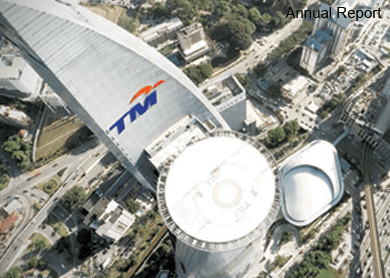
THERE are concerns that Telekom Malaysia Bhd (TM) will not be able to pay dividends as promised simply because of the heavy capital expenditure (capex) incurred by the second phase of its high-speed broadband project (HSBB2) and Packet One Networks (M) Sdn Bhd (P1).
Its managing director and CEO Tan Sri Zamzamzairani Mohd Isa refutes the concerns. “It shouldn’t be a worry. It used to be a worry when we launched the first HSBB, but we have proven that we can execute the plans well. After all, the company’s balance sheet is healthy and we have a clear dividend policy.”
TM has a policy of distributing annual dividends of RM700 million or up to 90% of normalised profit after tax and minority interests (Patami), whichever is higher. Last year, the total dividend payout was RM846.8 million, or dividend per share (DPS) of 22.9 sen.
In the last three years, TM’s DPS ranged from 22 sen to 26 sen, while dividend yield was between 3.6% and 4.7%.
As the investments on P1 might take years to bear fruit, the roll-out of HSBB2 and suburban broadband (SUBB), which were announced in the Eleventh Malaysia Plan (11MP), could be the next catalysts for TM.
The objective of the RM1.8 billion HSBB2 project is to build 1,000 new telecommunication towers and lay undersea cables. The 11MP indicated that HSBB2 will cover all state capitals and selected high-impact growth areas, with 250,000 ports across 410,000 premises by end-2016.
Meanwhile, the RM1.6 billion SUBB project will cover suburban and rural areas, providing 420,000 ports across 750,000 premises within five years.
“We do not provide guidance on operating cash flow. But for capex, we are guiding 20% of revenue for 2015, excluding HSBB2, SUBB, P1 and some major projects. We have not given explicit guidance beyond 2015 yet. But we can expect it to peak in 2016 with full-year impact from the mega projects,” says Zamzamzairani.
Like the first phase, he says, HSBB2 will also be a public-private partnership (PPP) between the government and TM, but the capex ratio has not been decided. “We are still discussing with the government. We will only know [the ratio] when we seal the deal. We hope to sign the contract this year,” says Zamzamzairani.
TM launched UniFi, the country’s first triple-play HSBB service, in 2010. Last year, its customers grew 14.8% to 729,000.
Zamzamzairani says the first HSBB was focused on the high economic impact and major industrial areas, while HSBB2 will be concentrating on the state capitals, selected major towns and suburban areas.
“The cost to serve [suburban areas] is higher when you start moving out from the centre. This is why it makes a lot of sense for us to continue with the PPP arrangement,” he says.
Most of the telco analysts who spoke to The Edge are not concerned about TM’s dividend outlook and payout ability, but uncertainties could arise after HSBB2 kicks in, they say.
CIMB Investment Bank Asean telco analyst Foong Choong Chen says there are no major issues. “Dividend payout depends on TM’s earnings performance, but it is unlikely to go below the minimum RM700 million mark. Based on 90% of our earnings forecast, we think TM should be able to pay out RM874 million to RM921 million in dividends over the next three years (2015, 2016 and 2017),” he says.
Foong adds that TM’s balance sheet is healthy, as its net debt to earnings before interest, taxes, depreciation and amortisation (Ebitda) at end-2014 was one time, below the 1.5 to 2 times ceiling for most telcos.
“Even if it has to spend more capex for HSBB2, TM still has room to gear up and is unlikely to have to resort to cutting its dividend payout. In addition, the capex for HSBB2 and P1 are spread out over several years, and the government is probably going to finance part of HSBB2,” he says.
Spanning 10 years, HSBB2 and SUBB have investment costs of RM1.8 billion and RM1.6 billion respectively. Based on the 80:20 split in HSBB1, TM is expected to invest about RM1.4 billion in HSBB2.
Meanwhile, an analyst with a local research house, who has a “buy” call on TM, says he is not too worried about its dividend outlook at this juncture.
“TM has a gross debt over Ebitda of 1.9 times, lower than its optimal ratio of 2 to 2.5 times, giving it room to gear up further,” he says.
However, due to the impact from P1, he expects TM’s DPS to decline from 23 sen last year to 21 sen this year, which translates into a total payout of RM780 million.
As at March 31, TM’s cash balances stood at RM2.8 billion, while its gross borrowings was at RM6.8 billion. A year ago, its operating cash flow was RM3.3 billion.
At 20% of revenue, TM is expected to allocate capex of about RM2.6 billion to RM2.8 billion this year. It also has to prepare at least RM700 million for dividends.
Fitch Ratings Singapore Pte Ltd in a July 1 report says TM’s funds from operations (FFO) of RM3.1 billion in 2015 may be insufficient to fully cover a capex of RM2.6 billion and dividend payout of RM900 million.
“We expect TM’s 2015 FFO-adjusted net leverage to rise to 1.8 times, near the 2 times level, where we may consider negative rating action. We feel there is little scope for deleveraging,” it says.
This article first appeared in The Edge Malaysia Weekly, on July 6 - 12, 2015.
Save by subscribing to us for your print and/or digital copy.
P/S: The Edge is also available on Apple's AppStore and Androids' Google Play.